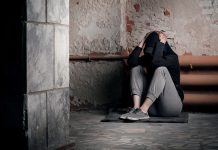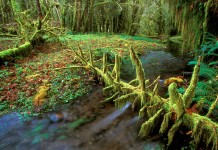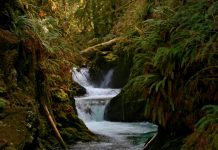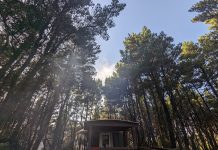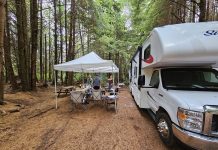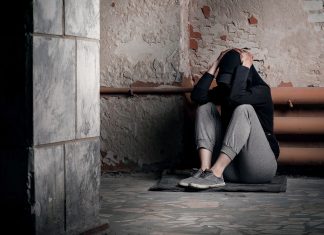“In one way, the story of the Heron Street bridges is the story of Aberdeen…it was from the boat landing that preceded even the first of the three structures, that the city spread across the salt marshes and tide flats to become the modern city of today.” Ben  Weatherwax, Grays Harbor radio personality and building contractor, wrote these words in his Hometown Scrapbook for the opening of the third Heron Street Bridge in 1950. Today this once new bridge is in need of replacement.
Weatherwax, Grays Harbor radio personality and building contractor, wrote these words in his Hometown Scrapbook for the opening of the third Heron Street Bridge in 1950. Today this once new bridge is in need of replacement.
Aberdeen was incorporated in 1888. At the time, a privately operated ferry carried passengers between the three-block city proper on the west bank to the new community around A.J. West’s sawmill on the East bank of the Wishkah River. The lumber town was growing rapidly. It was Captain A.J. West who initiated the construction of a swing bridge with a hand-operated turntable built entirely from fir timber. Heron Street Bridge Number One was completed in 1890.
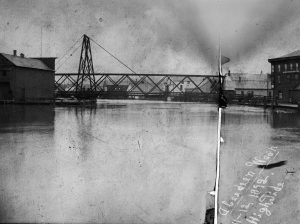
In 1905, Aberdeen introduced its streetcar railway system which needed stronger support than the simple wooden bridge could offer. It was time for Heron Street Bridge Number Two. A.J. West took over the lead once more. When the new steel structure with its concrete turntable, complete with streetcar tracks, opened, the citizens of Aberdeen were confident that this bridge would last forever. In this case, forever lasted 15 years.
In 1920, the bridge was temporarily closed for repairs and a pontoon structure was set up at Wishkah Street to divert traffic across the river. In 1921, the city council decided to erect a bridge at Wishkah Street while the Heron Street Bridge continued to have problems. It was closed permanently when funds ran out during the Depression.
After the war, Aberdeen suffered persistent traffic congestion. A group of citizens headed by Jake Vohs pushed for Heron Street Bridge number three. The new bridge was completed in 1950 and is still carrying US 12 eastbound traffic across the Wishkah River today. At the time of its construction, the third bridge was considered cutting edge. The Seattle Times described it as “…a new type of swing bridge, first of its kind in the state.” The design operates without counterweights and lacks the characteristic superstructure of older swing bridges.
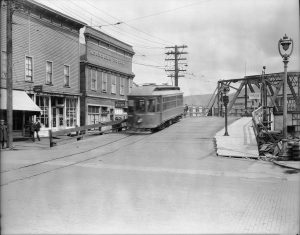
Today this bridge is owned by the Washington State Department of Transportation (WSDOT), which conducts inspections every other year. Recently these inspections have resulted in low ratings. “The pilings are a major problem,” says Dennis Engel, multimodal planning manager with the WSDOT, who is in charge of planning the bridge replacement. “They are made of untreated timber which is beginning to deteriorate in the saltwater.” Today, the worn out bridge conveys an average traffic load of 14,000 per day. The time has arrived for Heron Street Bridge number four.
Dennis Engel’s job is not easy. Many factors have to be considered before detouring 14,000 people daily for up to three and a half years. The top budget allotted by the WSDOT is $76.8 million which Engel considers generous. This amount comes to roughly 205 times the cost of the current bridge when it was built in 1950. Prices have gone up somewhat.
At present, the Heron Street Bridge Project is still in the input-gathering stage. Eight stakeholders are involved giving advice and presenting options: the City of Aberdeen, the City of Hoquiam, the Port of Grays Harbor, Grays Harbor Council of Governments, the Quinault Nation, the Chehalis Nation, Grays Harbor Transit. The City of Aberdeen has decided to put a hold on the East Aberdeen Mobility Project, which will lead train traffic on an overpass across the access roads to the Wishkah Mall. The City will not proceed until a decision has been made on the bridge design so that the two projects can be coordinated.
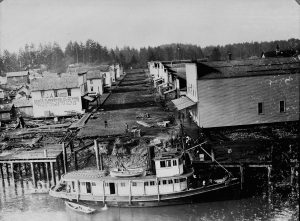
At this point, the WSDOT is considering four design options for the new bridge which were presented to the public at an open house at the Aberdeen Rotary Log Pavilion. Topics discussed included traffic revisions and the impact of the various designs on Zelasco Park and affected businesses. Only two of the four options fall within the allotted budget. The turnout for the open house was astonishing. An estimated 150 Harborites took the trouble to learn about the four plans and discuss them with Engel. ”Typically, only 20 to 25 people attend our open houses,” Engel says.
A final recommendation on one of the four alternatives is planned for summer 2019. Competitive bidding is not scheduled until 2022.
The WSDOT is also presenting the four options to the public in the form of an online survey. Close to a thousand individuals have participated so far. This eager participation demonstrates the concern felt on the Harbor about the Heron Street Bridge project.
The WSDOT posts updates on their website wsdot.gov.org.

